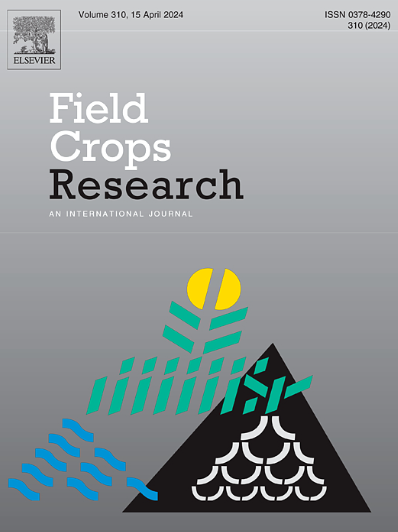Genetic progress in cotton fiber yield and its components in Türkiye
IF 5.6
1区 农林科学
Q1 AGRONOMY
引用次数: 0
Abstract
Context
Understanding the genetic progress in yield and its components is crucial for the effective planning of future research. However, no study has been conducted to examine the genetic progress in yield and yield components of cotton varieties released in Türkiye.
Objectives
In this context, the objectives of this study were to estimate the contribution of cotton breeding programs to the genetic improvement of fiber yield and its components in Türkiye, and moreover, to examine changes in yield components and their relationships with fiber yield.
Methods
Ninety-eight cotton varieties released in Türkiye between 1964 and 2013 were evaluated in field experiments during the 2014 and 2015 growing seasons.
Results
Fiber yields varied significantly among the varieties. Linear regression analysis revealed a highly significant positive relationship between fiber yield and the year of release (P < 0.001). Over the 50-year period from 1964 to 2013, cotton breeding programs achieved an annual increase of 1.07 % or 14.42 kg ha⁻¹ . Additionally, fiber yield was positively correlated with the boll number (0.802) and the ginning percentage (0.536), while negatively correlated with plant height (-0.367) and seed index (-0.407).
Conclusions
Improvement in fiber yield was mainly associated with an increase in the boll number and ginning percentage. Some key correlations were identified between fiber yield and its components. These relationships offer valuable insights into which traits can be enhanced concurrently in future breeding programs.
棉纤维产量及其构成因素的遗传研究进展
了解产量及其组成因素的遗传进展对有效规划未来的研究至关重要。然而,目前还没有研究对 rkiye释放的棉花品种的产量和产量成分的遗传进展进行研究。目的评价棉花育种方案对棉花纤维产量及其组成部分遗传改良的贡献,探讨棉花产量组成部分的变化及其与纤维产量的关系。方法对1964 - 2013年在基耶省发布的98个棉花品种在2014年和2015年生长季进行田间试验评价。结果不同品种间纤维产量差异显著。线性回归分析显示,纤维产量与释放年份呈极显著正相关(P <; 0.001)。1964年至2013年的50年间,棉花育种每年增长1.07 %,即14.42 kg ha⁻¹ 。纤维产量与铃数(0.802)、出苗率(0.536)呈显著正相关,与株高(-0.367)、种子指数(-0.407)呈显著负相关。结论棉纤维产量的提高主要与棉铃数和发芽率的提高有关。纤维产量与其组分之间存在一些关键的相关关系。这些关系为在未来的育种计划中可以同时增强哪些性状提供了有价值的见解。
本文章由计算机程序翻译,如有差异,请以英文原文为准。
求助全文
约1分钟内获得全文
求助全文
来源期刊

Field Crops Research
农林科学-农艺学
CiteScore
9.60
自引率
12.10%
发文量
307
审稿时长
46 days
期刊介绍:
Field Crops Research is an international journal publishing scientific articles on:
√ experimental and modelling research at field, farm and landscape levels
on temperate and tropical crops and cropping systems,
with a focus on crop ecology and physiology, agronomy, and plant genetics and breeding.
 求助内容:
求助内容: 应助结果提醒方式:
应助结果提醒方式:


